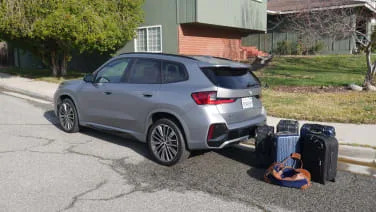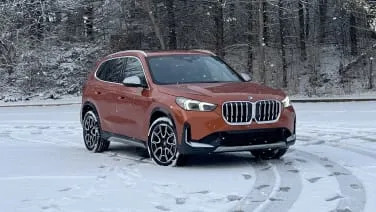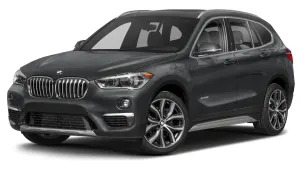2016 BMW X1
Perhaps more than any other model, the X1 exemplifies the shift going on at BMW. That the X1 is the first front-drive-based car to wear the BMW badge in the US is both remarkable and doesn't matter at all. Some background: The first X1, sold here for the latter half of its six-year run, was an Old BMW. Based on E90 3 Series underpinnings, it was basically a tall, last-gen 3 wagon, a car on short stilts. We loved it. It drove almost exactly like a good 3 Series at a time when that 3 Series was no longer available. It sold in okay numbers. It's gone now. This new X1, the 2016 model, is a sort of about face, or at least a right-hand turn in the engine compartment. This is New BMW. The base engine is again a 2.0-liter four-cylinder, a new design based on the company's modular engine architecture that can spit out threes, fours, and sixes using the same component set. It's mounted transversely, not longitudinally like in the rest of BMW's US offerings. It loses some horsepower to the last X1's 2.0 (228 hp versus 240) and a bit of torque (258 lb-ft down from 260). Again, few will notice. The optional 3.0-liter turbocharged six from the last generation is gone. Not many customers chose it, and the six likely wouldn't fit under the hood of this rearranged X1. EPA fuel-economy numbers match those from the 2015 xDrive28i exactly – 22 mpg city, 32 highway – so no gains there. So packaging won. There's really no other explanation for the longitudinal-transverse swap, except that maybe it's less expensive to build this way. EPA fuel-economy numbers match those from the 2015 xDrive28i exactly – 22 mpg city, 32 highway – so no gains there. But the packaging advantages are abundant. The interior is somewhat narrow, but it's opened up a bit by the lack of a transmission tunnel that would normally eat space between the front occupants. Instead, the center console is set low, with a tall shift lever rising practically from the floor up to meet your hand. There's storage forward of the shifter and a folding center armrest that opens for small items. The original X1 was sold here with rear-wheel as well as all-wheel drive. For obvious reasons, that won't be the case this time around. BMW also won't sell a front-drive model here (although one is offered in Europe and elsewhere) likely because it would involve the admission that this is not your average BMW, but instead a New BMW, one designed for more people and fewer enthusiasts. The four-cylinder is smooth and delivers its power with few hints that it's turbocharged. All of this from a company that still has a page on its consumer website dedicated to explaining the advantages of rear-wheel drive. The change was inevitable, but it might take some time to sink in. It's made a little easier to bear when you remember that BMW makes Minis, …
Full Review
Perhaps more than any other model, the X1 exemplifies the shift going on at BMW. That the X1 is the first front-drive-based car to wear the BMW badge in the US is both remarkable and doesn't matter at all. Some background: The first X1, sold here for the latter half of its six-year run, was an Old BMW. Based on E90 3 Series underpinnings, it was basically a tall, last-gen 3 wagon, a car on short stilts. We loved it. It drove almost exactly like a good 3 Series at a time when that 3 Series was no longer available. It sold in okay numbers. It's gone now. This new X1, the 2016 model, is a sort of about face, or at least a right-hand turn in the engine compartment. This is New BMW. The base engine is again a 2.0-liter four-cylinder, a new design based on the company's modular engine architecture that can spit out threes, fours, and sixes using the same component set. It's mounted transversely, not longitudinally like in the rest of BMW's US offerings. It loses some horsepower to the last X1's 2.0 (228 hp versus 240) and a bit of torque (258 lb-ft down from 260). Again, few will notice. The optional 3.0-liter turbocharged six from the last generation is gone. Not many customers chose it, and the six likely wouldn't fit under the hood of this rearranged X1. EPA fuel-economy numbers match those from the 2015 xDrive28i exactly – 22 mpg city, 32 highway – so no gains there. So packaging won. There's really no other explanation for the longitudinal-transverse swap, except that maybe it's less expensive to build this way. EPA fuel-economy numbers match those from the 2015 xDrive28i exactly – 22 mpg city, 32 highway – so no gains there. But the packaging advantages are abundant. The interior is somewhat narrow, but it's opened up a bit by the lack of a transmission tunnel that would normally eat space between the front occupants. Instead, the center console is set low, with a tall shift lever rising practically from the floor up to meet your hand. There's storage forward of the shifter and a folding center armrest that opens for small items. The original X1 was sold here with rear-wheel as well as all-wheel drive. For obvious reasons, that won't be the case this time around. BMW also won't sell a front-drive model here (although one is offered in Europe and elsewhere) likely because it would involve the admission that this is not your average BMW, but instead a New BMW, one designed for more people and fewer enthusiasts. The four-cylinder is smooth and delivers its power with few hints that it's turbocharged. All of this from a company that still has a page on its consumer website dedicated to explaining the advantages of rear-wheel drive. The change was inevitable, but it might take some time to sink in. It's made a little easier to bear when you remember that BMW makes Minis, …
Hide Full Review
Hide Full Review
Retail Price
$34,800 - $34,800
MSRP / Window Sticker Price
| Engine | 2.0L I-4 |
| MPG | Up to 22 city / 32 highway |
| Seating | 5 Passengers |
| Transmission | 8-spd w/OD |
| Power | 228 @ 5000 rpm |
| Drivetrain | all wheel |
| Curb Weight | 3,660 lbs |
Smart Buy Program is powered by 





